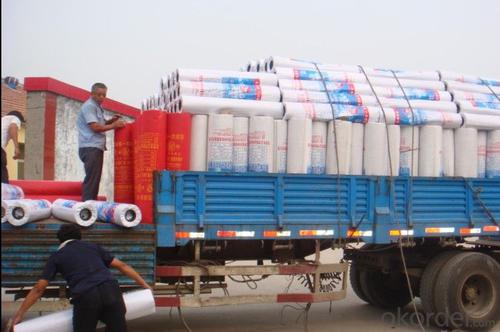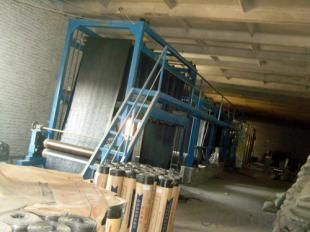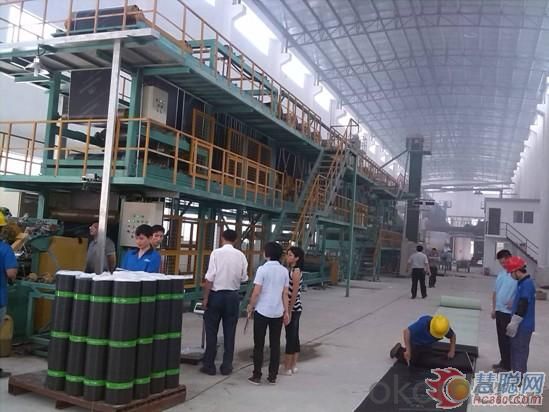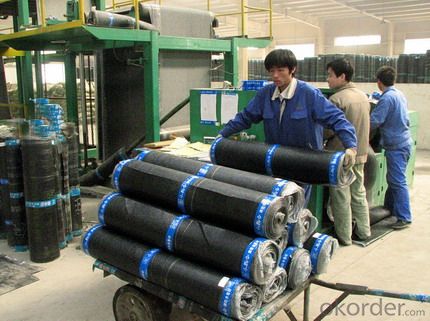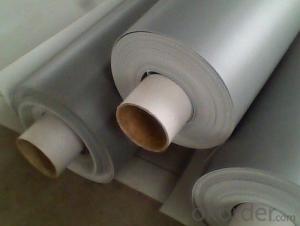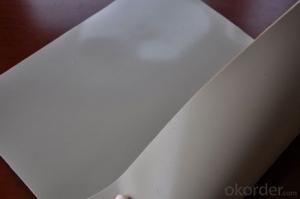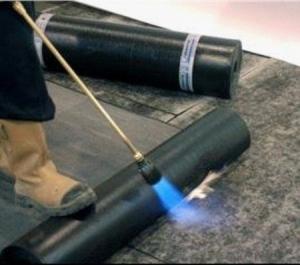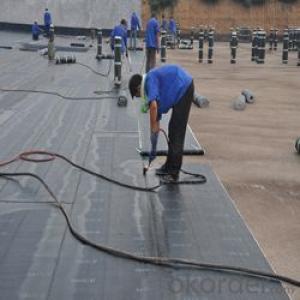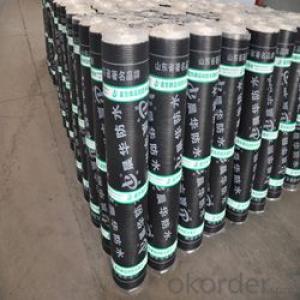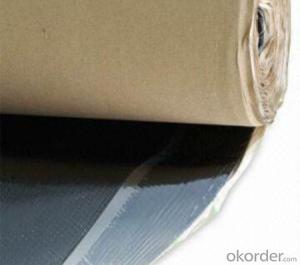SBS Waterproof Material for Construction
- Loading Port:
- Tianjin
- Payment Terms:
- TT OR LC
- Min Order Qty:
- 100 roll
- Supply Capability:
- 100000 roll/month
OKorder Service Pledge
OKorder Financial Service
You Might Also Like
Features:
1) SBS/APP modified bitumen waterproof membrane
2) conforms to the national standards
3) embossed belt and PE waterproof membrane
4) popular in Australia, Korea and the USA
5) technique:spunbond
6) length of roll:10m
7) core material:polyester mat or composite mat
Characteristic:
a) SBS modified bitumen waterproof membrane is specially used as waterproof material in cold area
b) APP is specially suitable for areas of high temperature and of strong sun-shine
SBS/APP Modified Bitumen Waterproof Membrane
c)Good performance in Good impermeability anti-puncture, anti-broker, anti-resistance, anti-erosion, anti-mildew, anti-weathering
d)Possess good tensile strength, elongation rate and size stability which could be well suited the substratedistortion and crack
- Q: Can waterproofing membranes be used on retaining walls?
- Yes, waterproofing membranes can be used on retaining walls. Waterproofing membranes are commonly used on retaining walls to prevent water infiltration and protect the structure from moisture-related issues such as seepage, efflorescence, and cracking. These membranes act as a barrier that prevents water from penetrating the retaining wall and causing damage. They are typically installed on the exterior side of the retaining wall, providing an additional layer of protection against water intrusion. Waterproofing membranes come in various forms, such as sheet membranes, liquid-applied membranes, and cementitious coatings, and can be chosen based on the specific needs and requirements of the retaining wall.
- Q: Can a waterproofing membrane be used on steel surfaces?
- Yes, a waterproofing membrane can be used on steel surfaces. Waterproofing membranes are designed to provide a protective barrier against water and moisture, and they can effectively adhere to and seal steel surfaces, preventing water penetration and potential damage.
- Q: Can a waterproofing membrane be used on roofs or only on vertical surfaces?
- A waterproofing membrane can be used on both roofs and vertical surfaces. It is a versatile solution that can effectively protect a variety of structures from water damage, including roofs, walls, and foundations.
- Q: Can waterproofing membranes be used on utility manholes?
- Yes, waterproofing membranes can be used on utility manholes. Waterproofing membranes provide a protective layer that prevents water infiltration into the manhole, helping to maintain its structural integrity and prevent damages caused by water exposure.
- Q: Can a waterproofing membrane be used for warehouses or storage facilities?
- Yes, a waterproofing membrane can be used for warehouses or storage facilities. It provides an effective barrier against water penetration, helping to protect the building and its contents from moisture damage.
- Q: Can a waterproofing membrane be used for a tunnel lining?
- Yes, a waterproofing membrane can be used for a tunnel lining. A waterproofing membrane is a barrier that is designed to prevent water infiltration and protect the structure from moisture damage. It can be applied to the inner surface of a tunnel to effectively seal and waterproof the lining. This helps to prevent water ingress, which can lead to corrosion, deterioration, and structural issues over time. Additionally, a waterproofing membrane can also serve as a protective layer against other potential issues such as chemical attacks, groundwater pressure, and freeze-thaw cycles. It is important to select a waterproofing membrane that is specifically designed for tunnel applications to ensure it can withstand the unique conditions and requirements of tunnels, such as high water pressure and potential movement. Regular inspections and maintenance are also crucial to ensure the long-term effectiveness of the waterproofing membrane in a tunnel lining.
- Q: Can a waterproofing membrane be used on precast gypsum surfaces?
- Yes, a waterproofing membrane can be used on precast gypsum surfaces. This membrane acts as a barrier to prevent water penetration and can be applied to protect the gypsum surface from moisture damage.
- Q: Does a waterproofing membrane affect the structural integrity of a building?
- No, a waterproofing membrane does not typically affect the structural integrity of a building. In fact, it is designed to protect the structural components of a building by preventing water infiltration and subsequent damage. A waterproofing membrane acts as a barrier against water penetration, ensuring that the building remains dry and free from moisture-related issues such as mold, rot, or deterioration. By keeping the building envelope intact, a waterproofing membrane helps maintain the structural integrity of the building and extends its lifespan. It is important to note that the installation of a waterproofing membrane should be done correctly and in accordance with industry standards to ensure its effectiveness and avoid any potential negative impact on the structure.
- Q: Can a waterproofing membrane be exposed to sunlight?
- Yes, a waterproofing membrane can be exposed to sunlight. In fact, many waterproofing membranes are designed to withstand prolonged exposure to sunlight without deteriorating or losing their effectiveness. However, it is always recommended to check the manufacturer's guidelines and specifications to ensure proper installation and maintenance of the waterproofing membrane.
- Q: Can a waterproofing membrane be used on stainless steel surfaces?
- Yes, a waterproofing membrane can be used on stainless steel surfaces. The membrane helps to prevent water penetration and protect the stainless steel from corrosion or damage caused by moisture.
Send your message to us
SBS Waterproof Material for Construction
- Loading Port:
- Tianjin
- Payment Terms:
- TT OR LC
- Min Order Qty:
- 100 roll
- Supply Capability:
- 100000 roll/month
OKorder Service Pledge
OKorder Financial Service
Similar products
Hot products
Hot Searches
Related keywords





